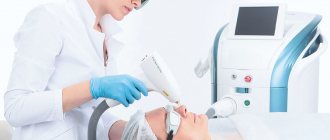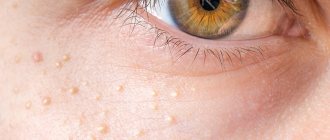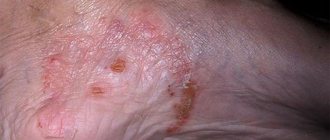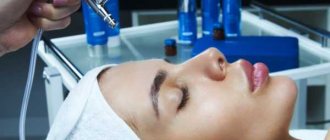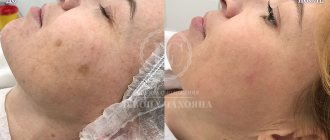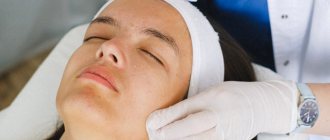Miles for adults
In adults, white spots on the face appear due to unsuitable face cream or the area around the eyes. Under no circumstances should they be squeezed out, because these are not classic pimples. They are harder and can leave scars.
Dermatological and cosmetic procedures involve the use of a special needle to remove milia.
However, there are also natural ways:
- Sugar-lemon peeling – sugar is a source of glycolic acid, it evens out skin tone, cleanses pores and removes dead skin cells, and lemon tightens pores and brightens the complexion;
- Honey – antibacterial property that soothes the skin;
- Tea tree oil – has antiviral, antibacterial and antifungal properties, and numerous studies have proven its effectiveness on various forms of acne;
- Castor oil – contains many essential vitamins and minerals that nourish the skin, and castor acid prevents the formation and spread of bacteria.
It is important to understand that natural remedies very rarely help if there are no internal problems.
Diagnostics
To undergo the examination, you must make an appointment with a dermatologist. The doctor will ask the patient about complaints and collect medical history information. The initial examination allows you to assess the symptoms of the disease and make a preliminary diagnosis. An accurate diagnosis is made after laboratory and instrumental studies.
Additional research:
- Blood analysis. This procedure allows the doctor to detect an autoimmune or inflammatory disease. The level of vitamins and microelements in the body is also assessed.
- Dermatoscopy is the examination of the skin using an optical device. The procedure is indicated for controversial symptoms.
- Examination of internal organs. The doctor must rule out diseases of the liver, thyroid gland and other organs involved in metabolism.
Special procedures are not always required to make a diagnosis. Sometimes a doctor can determine the type of depigmentation by external signs.
White spots on the skin are contagious molluscum or watery warts
If smooth white spots appear on the skin with a depression in the center and a few millimeters in size, which turn into scabs after scratching, then this is a rapidly multiplying harmless molluscum contagiosum virus. It is transmitted by touch and also through sexual intercourse.
This viral infection goes away in 6-12 months. If they interfere or new ones appear, skin changes can be removed:
- a special small spoon with a sharp edge;
- laser;
- using cryotherapy - ice treatment.
White spots on the skin – vitamin deficiency
White spots on the skin, like acne, can be a sign of a lack of essential fatty acids and vitamins A and D. They appear mainly on the face, arms, thighs and buttocks.
In these cases, it is important to eliminate saturated fats and enrich the diet with healthy fats by eating:
- salmon;
- sardines;
- nuts;
- seeds.
In addition, it is necessary to consume as many green vegetables rich in beta-carotene as possible (carrots, asparagus, apricots, broccoli, peppers, etc.). They are the main source of vitamin A. To provide the body with vitamin D, you should sunbathe for ten minutes a day.
Medicine also knows a type of anemia that occurs due to vitamin B12 deficiency - pernicious anemia. Vitamin B12 absorption occurs in the ileum (the back of the small intestine), but it must first be combined with a protein (Castle's factor) produced in the stomach.
If the stomach does not produce the necessary protein, this can lead to the formation of white spots on the body. The diagnosis is made based on:
- blood test;
- stomach examinations – gastroscopy and biopsy;
- Schilling test - measures absorption after taking radioactive vitamin B12 and essential protein.
Treatment includes injections of vitamin B12.
White spots on the skin – vitiligo
Vitiligo is a skin disease. Its symptom is white spots on the body, especially on the legs, resulting from the loss of skin pigment and the disappearance of melanocytes (epithelial pigment cells). Accompanied by itching at an early stage.
There are three different types of vitiligo:
- Localized vitiligo affects a small area of skin and occurs in 2% of cases.
- Generalized vitiligo – affects several areas such as the face and neck, trunk and limbs, and occurs in 90% of cases.
- Universal vitiligo affects more than 80% of the skin and occurs in 8% of cases.
It is usually harmless, but may accompany other conditions, such as:
- thyroid disease;
- diabetes;
- pernicious anemia - due to vitamin B12 deficiency;
- alopecia areata - the sudden appearance of one or more round, clearly demarcated areas without hair;
- Addison's disease;
- psoriasis;
- malignant melanoma - in this case this is a good sign, since it indicates the success of therapy.
White spots on the skin can range in size from a few millimeters to several centimeters. Later, the spots merge and can occupy large areas, while the itching disappears.
It occurs around the age of 20, and 30% of patients have a family history of vitiligo. When it comes to treatment, it is important to avoid sun exposure.
Currently, the most successful therapy is the method of physiotherapy - the use of ultraviolet rays. Corticosteroid creams and synthetic vitamin D supplements may be helpful.
How the disease begins and progresses: clinical manifestations
Most often, the first signs of the disease appear before the age of 20. Moreover, the disease vitiligo immediately begins in those places that have more contact with the sun - on the arms, face, legs.
The spots can be located symmetrically, covering large areas of the body, but they can appear only on one side of the body or cover a relatively small area. It is not uncommon for the spots to progress for a relatively short time (a year or two) and then stop growing. At the onset of vitiligo, it is very difficult to say how much tissue will be affected and whether it will stop at a certain level. Most often, there are cases when the spots gradually grow and cover more and more skin.
Are you experiencing symptoms of vitiligo?
Only a doctor can accurately diagnose the disease. Don't delay your consultation - call
Consequences of IPL depilation
White spots on the skin can also appear after IPL hair removal, which is permanent hair removal using a device that emits a wavelength that targets the hair pigment.
Since IPL hair removal is not recommended for people with darker complexions, white patches may appear if your skin type is misjudged. For the same reason, sun exposure should be avoided for two weeks after treatment.
The IPL method is also used to remove various hyperpigmentations as well as age spots. However, since the skin on some parts of the body (forearms, hands, etc.) is sensitive, white spots or tiny scars may remain.
Treatment of vitiligo in Moscow
Faced with such a problem, the patient, of course, is interested in how to cure vitiligo. Let us clarify right away that there are no 100% effective methods. Some treatment options can significantly slow down the process of tissue lightening - but there is always a risk that it will start again. It is easiest to achieve results in the early stages of the disease.
Now there are drugs for the treatment of vitiligo, but their effectiveness is not very high, so doctors prefer an integrated approach. Depending on the specific situation, vitiligo is treated using:
- some hormonal drugs. Usually they choose softer and more gentle ones;
- glucocorticoid creams. Under no circumstances should you prescribe such drugs yourself - they have serious side effects if used incorrectly;
- ointments for vitiligo with pimecrolimus or tacrolimus. They are prescribed for minor skin lesions and are often combined with phototherapy;
- PUVA therapy. It involves the use of drugs based on psoralen, as well as UV rays. The therapy is long-term, it usually lasts for six months to a year and is repeated several times a week.
Since vitiligo in humans gives an undesirable aesthetic effect, if the spots are not too pronounced, the skin color is evened out using healthy areas - they are lightened, which makes the spots less noticeable.
Drastic methods of treating vitiligo include skin transplantation, which is not recommended by doctors, since instead of an aesthetic problem, you can get the risk of serious complications.
Fungi on the skin - white spots
White spots on the body, especially on the arms and legs, are caused by warm and humid environments, oily skin, excessive sweating, hormonal changes and weakened immunity. They are lighter than the rest of the body and indicate a superficial fungal infection of the skin - Tinea lichen.
It is treated with sprays for various superficial dermatomycosis and antifungal shampoo. Additionally, after showering, you should dry your body with a rougher towel to remove dead skin cells.
It takes some time for the pigment of the affected skin to become equal to the rest of the body.
White spots on the body as a result of pityriasis versicolor can be of different sizes and unevenly distributed over the surface of the skin.
Self-medication: does it work?
Home remedies are not a treatment, but rather a prevention of vitiligo. To keep your skin in good condition and protect it from unnecessary stress, we recommend:
- use remedies against the harmful effects of the sun. These are creams with SPF, which are available for both the body and face. It is recommended to apply such creams in a sufficient (thick) layer, and also to constantly renew them if required by the instructions;
- choose safe self-tanning products – at the moment these are formulations with dihydroxyacetone;
- strengthen the immune system, monitor the quality of tests. If necessary, take courses of vitamins (on the recommendation of an endocrinologist);
- monitor your psychological state. Since psychosomatics for vitiligo is considered one of the probable causes, it is necessary to take care of your peace of mind and comfort.
It is believed that the condition of the skin is improved by decoctions and compresses (for example, from radish seeds), as well as tinctures for internal use - based on chamomile, St. John's wort, oregano and other herbs. It is important to understand that all these remedies will not help stop the disease or reverse it. These are auxiliary options for maintaining immunity. But be careful: natural remedies also have side effects and can cause allergies.
White spots on the skin of the feet
Small white spots on the skin, usually appearing on the extremities, especially the legs, are called ulcer spots. This is a vascular cutaneous abnormality. They are not dangerous and cannot be treated.
Their appearance is associated with genetics and smoking. Spots on the legs are a sign of poor blood circulation in the subcutaneous capillaries. They disappear with short-term pressure on the skin or lifting of the limbs. More noticeable at low temperatures. They appear between the ages of 20 and 40 and are more common in women.
Since this is a harmless phenomenon, the problem is only of an aesthetic nature.
Therefore, dermatologists recommend the following:
- to give up smoking;
- taking in enough fluids;
- physical activity;
- oil massage;
- shower with warm water;
- colloidal selenium - a dietary supplement that should be taken for at least six months, stimulates organ function and restores the balance of the immune system;
- cryotherapy – increases cellular and humoral immunity against tumors.
White spots on the skin of the feet can also indicate certain diseases, so it is important to consult a dermatologist.
Skin pigmentation
The skin is an independent organ with a complex structure.
The skin contains epithelial and connective tissue components that perform specific functions. Pigment cells called melanocytes are responsible for the color of integumentary tissues. The more melanin in such cells, the darker the skin. Normally, the pigment is evenly distributed in the tissues, but some diseases can affect the content of the substance. Melanocytes can also form benign tumors called moles. The main function of the pigment is to protect the skin and underlying tissues from ultraviolet radiation from the sun. Melanin absorbs rays and prevents sunburn. At the same time, prolonged exposure to ultraviolet radiation leads to an increase in the production of pigment (tanning). The lack of the substance in the integumentary tissues leads to the fact that even short-term solar irradiation is accompanied by the appearance of burns.
Melanocytes are located in the epidermis and dermis. These are the superficial and middle sections of the skin, necessary for protecting the body, synthesizing vitamin D, storing blood and maintaining metabolism. The condition of internal organs can affect the amount of pigment in melanocytes. For example, endocrine disorders often lead to the formation of light spots.
